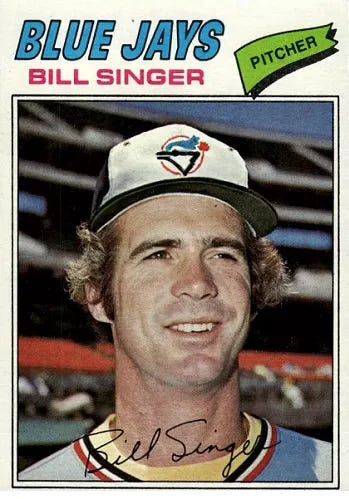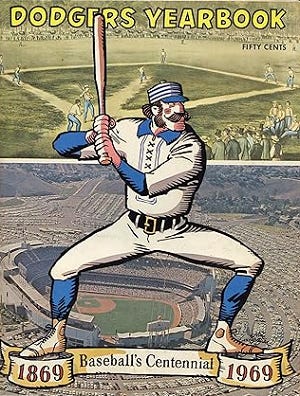Note: When you click on links to various merchants in this newsletter and make a purchase, this can result in this newsletter earning a commission. Affiliate programs and affiliations include, but are not limited to, the eBay Partner Network and Amazon Associates.
1977 O-Pee-Chee Bill Singer (#85) - Card of the Day
(affiliate link)
“Bill Singer” is a baseball name that has mostly been lost to the ravages of time, but one that tends to come up around Opening Day. April 7th, in particular, is a day when you’re likely to find the right-hander’s name spiking — relatively speaking — in conversations among old-time diamond fans wherever we may congregate.
The reason for that timing is at least two-fold.
First, Singer recorded baseball's first official save on April 7, 1969. (The save rule went into effect for the 1969 season.)
That day, with the Dodgers clinging to a 3-2 lead at Crosley Field, Singer relieved Don Drysdale in the bottom of the seventh inning. From there, Singer shut down the Cincinnati Reds for three innings, allowing a single base runner...Pete Rose walked with one out in the eighth.
Los Angeles didn’t score in their final two times to the plate, either, and held on to win by that same 3-2 score. Big D got the win, and Singer got the save, one of only two in his big league career. The other came with the Angels in 1975.
Rewinding to 1969, Singer made his first start of the 1969 season five days after his Opening Day save. In that April 12 outing, he went eight innings to beat the Astros 5-1. Jim Brewer pitched the 9th to pick up his first official save.
Singer went on to make 39 more starts in 1969, finishing the year 20-12 with a 2.34 ERA and 247 strikeouts in 315.2 innings. That performance put him in the Hall of Fame company of Bob Gibson, Fergie Jenkins, and others.
(affiliate link)
At that point, Singer was a bona fide pitching star, having landed his first All-Star berth in the summer of ‘69 and establishing himself as at least co-co-ace of the Dodgers staff, slotting between Claude Osteen and Don Sutton at the top of the rotation.
That trio’s importance to L.A. became all the more pronounced when Drysdale tossed his last big league pitch in August.
Singer was still just 25 years old by the end of the 1969 season, and he had already logged three seasons as a full-time starter — and one-time reliever — for one of the most pitching-rich of all franchises. The future looked bright, for sure, but 1970 ended up being a bit dingy.
Battling injuries and hepatitis, Singer managed just 16 appearances (all starts), but he was still top-shelf when he took the mound. To wit, his 8-5 record and 3.13 ERA were bolstered by five complete games, three shutouts, and a no-hitter against the Phillies at Dodger Stadium on July 20.
Back in the (mound) saddle again, Singer looked like he had righted the ship and drew the Opening Day start in 1971. It turned out to be another sort of rough campaign, though, as Singer went 10-17 with a 4.16 ERA.
Things were even bleaker in 1972, as Singer made just 26 appearances (25 starts) and went 6-16, though with an improved 3.67 ERA.
Then came November.
Looking to shake things up and break out of a rut of three straight second-place finishes, the Dodgers traded Singer, Billy Grabarkewitz, Frank Robinson, Mike Strahler, and Bobby Valentine to the (more or less) crosstown Angels for Ken McMullen and Andy Messersmith.
The Dodgers again finished second in the National League West in 1973 before taking the division and the National League pennant in 1974. Messersmith was the ace of that ‘74 team and again in 1975 before departing as one of baseball’s first free agents.
Singer, meanwhile, found Anaheim to his liking. In 1973, he made a career-high 40 starts, tossed 19 complete games, and went 20-14 with a 3.32 ERA. The next year, was marred by back problems, though, and then he struggled through an ugly 1975 season that left him at 7-15 with a 4.98 ERA…and that second save (against the Royals on April 30).
The Angels traded Singer to the Rangers for Jim Spencer in December 1975. In Arlington, the right-hander rebounded to go 4-1 with a 3.69 ERA, which made him attractive trade bait early in the Bicentennial season.
And, indeed, the Twins came calling on June 1, 1976, sending Bert Blyleven and Danny Thompson to Texas for Singer, Mike Cubbage, Jim Gideon, and Roy Smalley (and cash).
In Minnesota, Singer posted a 9-9 record with a 3.77 ERA.
The Twins finished third in the old American League West, five games out of first place and 2.5 out of second. That winter, with expansion looming, the Twins — like all other American League teams — had to decide which players to protect from the upcoming expansion draft.
Singer didn’t make the cut. But he did make it to the Blue Jays draft board, and Toronto made him the 28th overall expansion pick in November of 1976
A little over five months later, on April 7, 1977, Singer threw the first pitch in Blue Jays history, drawing the Opening Day start against the White Sox at Exhibition Stadium. That day, he pitched four-and-a-third innings and gave up 11 hits, three walks, a home run, and four runs (three earned). He also struck out five batters en route to a no-decision.
But, hey, the Jays won the game 9-5. And Singer stayed in the rotation into June before hitting the disabled list. Back on the staff in July, Singer continued to struggle, and manager Roy Hartsfield moved him to the bullpen for a game.
It didn’t help much, though, and Singer tossed his final big league pitch on July 16. His 1977 numbers: 2-8, 6.79 ERA.
Even so, Canadian collectors could pull Toronto’s first-ever big league pitcher from their O-Pee-Chee packs all summer long — that’s the card you see up top.
And collectors in the States got our own shot of the former Dodgers ace (turned Dodgers closer, turned Angels ace, turned Angels closer, turned Blue Jays opener) thanks to his base Topps card (#346):
(affiliate link)
All in all a pretty interesting and significant career, and one that certainly bears remembering on April 7, at the very least.
Oh, and on April 24 — because today, William Robert Singer (aka, The Singer Throwing Machine) turns 81 years old.
(affiliate link)
Hey, What’s Going on Here??
Hall of Famer Ron Santo collected the first hit off Singer, a single to center field at Wrigley Field in the bottom of the second inning on September 24, 1964. Not many people were there to witness the event — Baseball Reference lists the attendance for the Thursday afternoon game at (gasp!) 629.
Ten years later, with Singer coming off his second and final All-Star season, Santo was appearing in wax packs on his final Cubs card. That 1974 Topps, as you see above, is a doozy. Read all about it right here.
Answer to yesterday’s trivia question: Howard Johnson hit 228 home runs and stole 231 bases in his 14-year big league career.








